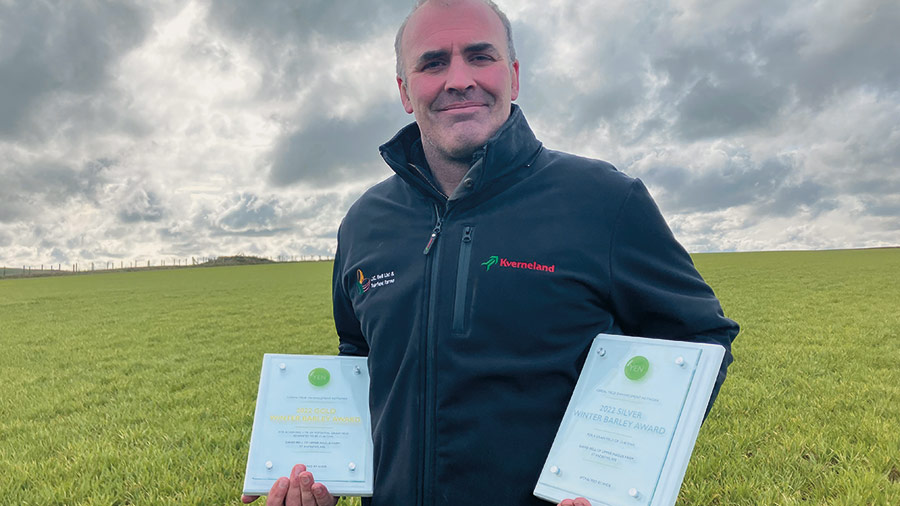Gold-winning winter barley crop smashes yield potential

Mixed farmer David Bell smashed his winter barley yield potential with a 13.4t/ha crop last harvest – 17% greater than the farm’s perceived 11.5t/ha optimum.
This won him gold in the 2022 Yield Enhancement Network (YEN) awards for the best percentage of potential winter barley yield and placed him in silver place for overall yield, behind Tim Lamyman’s world record-breaking 16.2t/ha crop.
David says success is down to his diverse rotation which integrates beef cattle, grass, potatoes and the plough.
A focus on soil structure has lifted organic matter levels to 7-8% at Upper Magus Farm, west of St Andrews in Fife – busting the rhetoric that ploughing and potatoes cannot contribute to healthy and sustainable soils.
See also: Ex-beef farmer reveals how he grew award-winning OSR crop
Winning ways
It was the two-row winter barley variety Bordeaux which claimed the gold and silver awards, grown for cattle feed at the 400ha farm.
“The crop looked gorgeous with its beautiful red-tinged awns,” says David. “It was a great sight to see, especially when planted in a north-facing field.”
Drilling the crop in early September at 400 seeds/sq m to overcome challenging ground conditions, David admits that an error occurred on his Sky Easy drill.
This caused tramlines to be planted across the entire field. Despite this, he thinks it worked in his favour, allowing a greater proportion of light to be intercepted by the canopy.
The crop was planted following an environmental cover crop of species such as clover, beans and phacelia, which was sprayed off and ploughed in.
“It was sown in a block of land we began farming 10 years ago and we really brought the soil back to life,” says David.
“We’re proud of what we achieved through the rotation and farmyard manure applications.”

David Bell holds his YEN awards © © MAG/Emma Gillbard
Array of nutrition
A “little and often” nutrition programme, with a broad spectrum of formulas including placement fertiliser, foliar feeds and granular – aims to keep crops stress-free with a plentiful supply.
“By using a broad range of nutrition products, we are not reliant on one sole method of nutrition uptake,” he says.
“This means we can keep crops greener for longer in a range of different environments when certain types of uptake may be limited.
“Just throwing nitrogen at crops is far from the best way of achieving good yields and profit.
“Taking part in various YEN entries over the years has been a huge learning experience and taught me how to measure and manage crops individually, rather than blanket treating.”
He says the field was prioritised throughout the season and he opted for a full-spec fungicide programme. “Whenever a fungicide was applied, we added a mix of micronutrients to reduce the risk of crop stress.”
Thanks to a season of low disease pressure, heavy clay soils which retained moisture well and a north-facing field which prevented crops from burning off early, the barley performed well.
David says: “To achieve over 100% of our potential yield is so pleasing and showcases we’re using the right practices on farm.”
Cultivation cutbacks with a flexible approach
Upper Magus Farm historically used a plough-based system, but today Fife farmer David Bell uses a flexible cultivation strategy, dependent on individual field conditions and crop type.
All spring crops have been min-tilled this season, while his winter cropping cultivation involved:
- 10% ploughed
- 30% min-tilled
- 60% direct drilled.
“We were keen to cut back on cultivations to save fuel and labour costs. But there are always unintended consequences,” says David.
“Reducing tillage has increased brome populations so the plough remains an important integrated pest management tool.”
